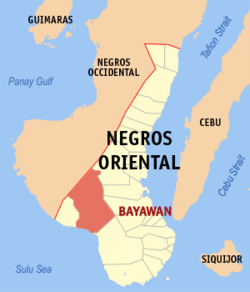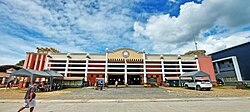
Back باياوان Arabic Bayawan BCL Bayawan CBK-ZAM Bayawan CEB Bayawan German Bayavan Esperanto Bayawan Spanish Bayawan French Bayawan ID Bayawan ILO
This article needs additional citations for verification. (March 2013) |
Bayawan | |
|---|---|
| City of Bayawan | |
St. Tomas de Villanueva Parish Church (top), Bayawan City Hall (bottom) | |
| Anthem: "Ibayaw ang Bayawan" | |
 Map of Negros Oriental showing the location of Bayawan | |
Location within the Philippines | |
| Coordinates: 9°22′N 122°48′E / 9.37°N 122.8°E | |
| Country | Philippines |
| Region | Negros Island Region |
| Province | Negros Oriental |
| District | 3rd district |
| Founded | 1872 |
| Cityhood | December 23, 2000 |
| Named for | Visayan term bayaw, meaning "raise" |
| Barangays | 28 (see Barangays) |
| Government | |
| • Type | Sangguniang Panlungsod |
| • Mayor | John "Jack" T. Raymond Jr. (NPC) |
| • Vice Mayor | Henry E. Carreon Jr. (NPC) |
| • Representative | Vacant (Martin Romualdez serves as legislative caretaker) |
| • City Council | Members |
| • Electorate | 78,855 voters (2022) |
| Area | |
• Total | 699.08 km2 (269.92 sq mi) |
| Elevation | 225 m (738 ft) |
| Highest elevation | 1,827 m (5,994 ft) |
| Lowest elevation | 0 m (0 ft) |
| Population (2020 census)[3] | |
• Total | 122,747 |
| • Density | 180/km2 (450/sq mi) |
| • Households | 29,403 |
| Economy | |
| • Income class | 1st city income class |
| • Poverty incidence | 33.73 |
| • Revenue | ₱ 1,327 million (2020) |
| • Assets | ₱ 3,986 million (2020) |
| • Expenditure | ₱ 1,117 million (2020) |
| Service provider | |
| • Electricity | Negros Oriental 2 Electric Cooperative (NORECO 2) |
| Time zone | UTC+8 (PST) |
| ZIP code | 6221 |
| PSGC | |
| IDD : area code | +63 (0)35 |
| Native languages | Cebuano Magahat Tagalog |
| Website | www |
Bayawan, officially the City of Bayawan (Cebuano: Dakbayan sa Bayawan), is a component city in the province of Negros Oriental, Philippines. According to the 2020 census, it has a population of 122,747 people.[3]
Bayawan used to be known as New Tolong, and only had its modern name starting 1952.[5]
Bayawan became a chartered city in December 2000. It boasts its distinction as a "Character City" (International Association of Character Cities) and a pioneer "Healthy City" (DOH certified) in the Philippines. The Asian Institute of Management recognized the city as "one of the Top 10 Best Cities to Live In in the Philippines (Small Cities Category)" under its Competitive Cities Survey of 2007.[6]
The town is home to the Minagahat language, the Indigenous language of Southern Negros as listed by Komisyon sa Wikang Filipino. The language is vital to the culture and arts of the people of southern Negros.
- ^ City of Bayawan | (DILG)
- ^ "2015 Census of Population, Report No. 3 – Population, Land Area, and Population Density" (PDF). Philippine Statistics Authority. Quezon City, Philippines. August 2016. ISSN 0117-1453. Archived (PDF) from the original on May 25, 2021. Retrieved July 16, 2021.
- ^ a b Census of Population (2020). "Region VII (Central Visayas)". Total Population by Province, City, Municipality and Barangay. Philippine Statistics Authority. Retrieved July 8, 2021.
- ^ "PSA Releases the 2021 City and Municipal Level Poverty Estimates". Philippine Statistics Authority. April 2, 2024. Retrieved April 28, 2024.
- ^ "An Act to Change the Name of the Municipality of New Tolong, Province of Oriental Negros, to Bayawan". LawPH.com. Archived from the original on July 11, 2012. Retrieved April 9, 2011.
- ^ NSCB - 2001 Factsheet - 12 New Cities Created Archived April 23, 2006, at the Wayback Machine, July–December 2000.





